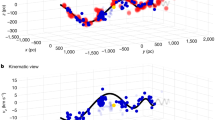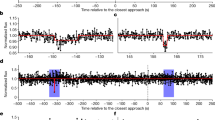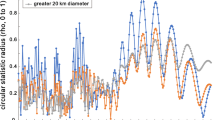Abstract
Recent data obtained from the Voyager spacecrafts and ground-based measurements indicate: (1) the rings have a thickness of at most 150 m (ref. 1) and probably several times less2,3; (2) the rings are mostly composed of ice particles ranging from centimetres to metres in size4; (3) the rings are subdivided into a large number of ringlets with a radial dimension ranging from 10-km down to the several metres resolution of the Voyager spacecraft's camera5; (4) the B ring contains very many optical depth variations (0.6–3)3. This behaviour is essentially determined by the collisional properties of the rings' ice particles. Here we report some preliminary results from an experiment designed to measure the coefficient of restitution of ice particles colliding at impact velocities relevant to Saturn's rings. We apply these results to simple dynamical models for Saturn's rings and deduce the rings' thickness to be ≺5 m. We also show that regions with optical depth <0.5, such as the B ring, are unstable to viscous diffusion. Such an instability may be the cause of optical depth variations in the B ring.
This is a preview of subscription content, access via your institution
Access options
Subscribe to this journal
Receive 51 print issues and online access
$199.00 per year
only $3.90 per issue
Buy this article
- Purchase on Springer Link
- Instant access to full article PDF
Prices may be subject to local taxes which are calculated during checkout
Similar content being viewed by others
References
Lane, A. L. et al. Science 215, 537–543 (1982).
Zebker, H. A. & Tyler, G. L. Science (in the press).
Esposito, L. W., O'Callaghan, M. & West, R. A. J. geophys. Res. 88, 8643–8649 (1983).
Marouf, E. A., Tyler, G. L., Zebker, H. A., Simpson, R. A. & Eshleman, V. R. Icarus 54, 189–211 (1983).
Smith, B. A. et al. Science 215, 504–537 (1982).
Cook, A. F. & Franklin, F. A. Astr. J. 69, 173–200 (1964).
Brahic, A. Astr. Astrophys. 54, 895–907 (1977).
Goldreich, P. & Tremaine, S. Icarus 34, 227–239 (1978).
Hameen-Antilla, K. A. & Lukkari, J. Astrophys. Space Sci. 71, 475–497 (1980).
Lynden-Bell, D. & Pringle, J. Mon. Not. R. astr. Soc. 168, 603–637 (1974).
Goldsmith, W. Impact (Arnold, London, 1960).
Hameen-Antilla, K. A. Astrophys. Space Sci. 58, 477–519 (1978).
Ward, W. R. Geophys. Res. Lett. 8, 641–643 (1981).
Lukkari, J. Nature 292, 433–435, (1981).
Lin, D. N. C. & Bodenheimer, P. Astrophys. J. Lett. 248, L83–L86 (1981).
Andrew, J. P. Phil. Mag. 9, 593–610 (1930).
Landau, L. & Lifshitz, E. M. Theory of Elasticity (Pergamon, London, 1959).
Borderies, N., Goldreich, P. & Tremaine, S. in Planetary Rings (eds Greenberg, R. & Brahic, A.) (University of Arizona, in the press).
Weidenschilling, S. J., Chapman, C. R., Davis, D. R. & Greenberg, R. in Planetary Rings (eds Greenberg, R. & Brahic, A.) (University of Arizona, in the press).
Lissauer, J. J., Shu, F. H. & Cuzzi, J. N. Proc. IAU Colloq. 75, (in the press).
Shu, F. H., Cuzzi, J. N. & Lissauer, J. J. Icarus 53, 185–206 (1983).
Borderies, N., Goldreich, P. & Tremaine, S. Nature 299, 209–211 (1983).
Author information
Authors and Affiliations
Rights and permissions
About this article
Cite this article
Bridges, F., Hatzes, A. & Lin, D. Structure, stability and evolution of Saturn's rings. Nature 309, 333–335 (1984). https://doi.org/10.1038/309333a0
Received:
Accepted:
Issue Date:
DOI: https://doi.org/10.1038/309333a0
This article is cited by
-
A dense ring of the trans-Neptunian object Quaoar outside its Roche limit
Nature (2023)
-
Modelling of the coefficients of restitution for prolate spheroid particles and its application in simulations of 2D granular flow
Granular Matter (2022)
-
Parametric analysis of a dynamical model of the axial vibration of a vibration-assisted drilling tool, a vibro-impact system with multiple impacts
Archive of Applied Mechanics (2021)
-
Temperature distribution in driven granular mixtures does not depend on mechanism of energy dissipation
Scientific Reports (2020)
-
Vibro-impact model and validation of the axial dynamics of a vibration-assisted drilling tool
Journal of the Brazilian Society of Mechanical Sciences and Engineering (2020)
Comments
By submitting a comment you agree to abide by our Terms and Community Guidelines. If you find something abusive or that does not comply with our terms or guidelines please flag it as inappropriate.



